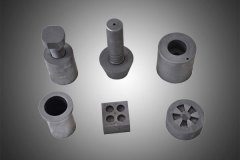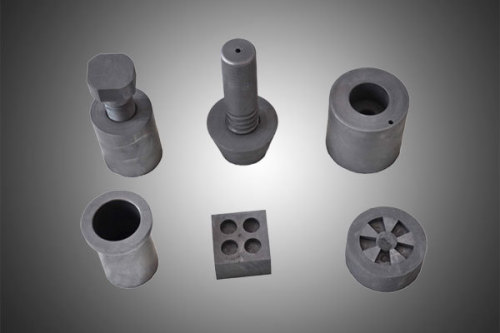Because of the advantages of hot-pressing method, it has been widely used in the current industrial production, especially in the production of diamond bits. In the hot pressing of diamond bit, the pressing film is the most critical. It has high strength, good conductivity, high temperature resistance, non-polluting bit matrix and machinability. Graphite has special properties of metal and non-metal, so it becomes a good die material for hot-pressing drill.
1 Graphite mould overview
Mould is a basic process equipment used in industrial production, and the mould industry is the basic industry of the national economy. In modern industrial production, the product parts are widely used in stamping, forging forming, die casting, extrusion forming, plastic injection or other forming processing methods, and matching with the forming mould to form the blank into parts that meet the product requirements. The tools and products we use in daily production and life range from the base of the machine tool to the outer casing of the machine, to a small screw, button and shell of various household appliances, all of which have a close relationship with the mould. In recent years, the mould industry has developed rapidly. Graphite materials, new processes and increasing mould factories continue to impact the mould market. Graphite has gradually become the material of choice for mould making with its good physical and chemical properties.
2 graphite mould properties
2.1 Machinability
Since the hardness of graphite is between 25 and 80 Shore, it is very convenient when it is used for cutting. Not only that, but also it can be glued and made into moulds of various shapes.
2.2 Resistivity
The electrical conductivity of graphite is related to its raw materials, processing methods and temperature. The temperature coefficient tends to be negative. Due to the good electrical conductivity of graphite, it becomes a good heating material to heat the bit body.
2.3 Thermal conductivity
The thermal conductivity of graphite is hundreds of times larger than that of ordinary non-metals, and even larger than that of carbon steel, but it decreases to 1000 °C as the temperature rises to about 50% at room temperature. The good thermal conductivity of graphite makes the bit body heating fast and heat transfer uniform during hot pressing.
2.4 Thermal expansion coefficient
The coefficient of expansion of graphite at room temperature is 3 x 10-6 / ° C, which is only 1/5 of iron. It increases as the temperature increases, and is 5.4 × 10 -6 / ° C at 900 - 1000 ° C.
The smaller expansion coefficient of graphite is used as the advantage of hot pressing die: first, the mould can withstand the sharp change of temperature without cracking, and second, after the hot pressing, the expansion coefficient of the bit body is larger than that of the graphite die, so the carcass and the mould There will be a shirring between the pieces, which is easy to demould and does not damage the graphite mould.
2.5 Non-wetting with metal
Graphite does not substantially wet with most metals when heated, which makes the drill bit easy to demould after hot pressing.
2.6 Chemical properties
Graphite is stable at normal temperature and has strong corrosion resistance. It is oxidized in air at a temperature of 450-50 ° C, and CO gas is produced at the same time, so that the bit body and diamond are protected during hot pressing.
3 hot pressing mould graphite material selection
3.1 General choice of graphite materials
According to the current process conditions of hot-pressed diamond drill bits, the pressure is about 100-50 kg/cm 2 and the temperature is about 950-1100 °C. The material of the hot-pressed graphite mould is high-purity dense graphite, and the following two points should be considered: (1) The mechanical strength of graphite should be selected higher, such as compressive strength should be above 40 kg/cm 2, which can meet the pressure. Process requirements, and the mould will not be too large, saving materials. (2) The density of graphite should be high and the porosity should be small. Because the metal powder and a small amount of oxide easily enter the pores of the surface of the graphite mould during hot pressing of the drill bit, the mould becomes brittle and easily cracked, and the surface of the mould is pulled, the inner hole becomes large, and the number of repeated use of the mould is shortened. At the same time, due to the high porosity of graphite, the surface of the carcass is rough. Therefore, the density of dense graphite is generally required to be 1.6 g/cm 3 or more, and the porosity is 30% or less, which basically satisfies the requirements.
3.2 Requirements for graphite by two hot pressing methods
There are two main methods for hot-pressed diamond drill bits. The resistance hot-press and medium-frequency induction hot-press are different, and the requirements for graphite are different. (1) Resistance hot pressing: The resistance hot pressing uses a graphite mould and a drill or other diamond tool as a resistance element, and generates heat after being energized at both ends. In the same case, the greater the resistivity of graphite, the greater the heating power. For the upper and lower pads, the heat energy is not dissipated too much, and graphite with high strength and low thermal conductivity must be selected. (2) Intermediate frequency induction hot pressing: The intermediate frequency power supply passes through the induction coil to generate eddy current heating in the graphite mould. Here, the lower the resistivity of the graphite mould, the more favorable it is to absorb the eddy current and the heat generated, so a graphite material with low resistivity is used as much as possible. The upper and lower gaskets at both ends are made of high strength and low thermal conductivity.
4 Manufacture of graphite moulds
4.1 Mechanical processing methods
Due to the good machinability of graphite, graphite rods or blocks can be formed into various mould shapes by mechanical processing, which is currently a commonly used method.
The relevant tool and machining parameters are as follows: (1) Tool material. There are two kinds of tool materials: high speed steel cutter and hard alloy cutter. The former is simple to manufacture, good in toughness, impact resistance, hardness HRC62-65, heat resistance 500-60 °C. This tool is used less and is mainly used for forming. Processing; the latter still has good cutting performance at 100 ° C, high hardness and good wear resistance. (2) Tool angle. The rake angle is 0-10 degrees and the rear is 10-20 degrees. (3) Machining cutting parameters. For machining, when the workpiece diameter is 50-100 mm, the rotation speed is 600-750 rpm, the roughing speed is 0.5 mm/rev or more, the finishing speed is 0.4 mm/rev or less; when milling, the multi-knife with diameter 100 mm The milling cutter has a rotational speed of 200-230 rpm, and the table travel speed is 1-1.2 m/min. When the planing is performed, the table travels at a speed of 45 m/min and the cutting distance is 1-15 mm.
4.2 Press sintering method
The press-sintering method can directly press-squeeze the size and shape of the mould without requiring or performing the most cutting. In China, useful scale graphite powder, powdered graphite powder and heavy asphalt are pressed according to a certain weight ratio, and the moulding pressure is 500-700 kg/cm 2 and the sintering temperature is 1150 ° C to manufacture a mould for hot-press geological bit. Pressing and burning the mould can greatly save raw materials and processing man-hours, reduce pollution, and thus greatly reduce the cost of the mould. It is the direction of graphite mould manufacturing and should be taken seriously.
5 Ways to increase the number of times the graphite mould is reused
In the use of graphite moulds, some cracks, inner pores, and enlargement after one or several uses are not reusable. However, if appropriate measures are taken, the number of reuses can be increased and costs can be reduced.
(1) The cracking of the mould is mainly due to insufficient strength, small gap between the steel body and the mould sleeve, uneven pressure and uneven pressure of the press. (2) The inner hole of the graphite is oriented to make the pores smaller, and the compressive strength can be increased to 500 kg/cm 2 or more. The method is to decompose hydrocarbons into carbon under a vacuum of 900-1000 ° C and deposit them on the graphite body in a certain direction. (3) The graphite surface is coated with silicon to increase the oxidation resistance. (4) Apply an intermediate layer on the surface of the mould, such as alumina and ethylene glycol or natural graphite powder and ethylene glycol, so that the film is easy to remove and the inner pores are not enlarged.
6 Summary
Graphite moulds are widely used for hot-pressing diamond tools due to their unique properties, but the materials used to make such graphite moulds should be as high as possible with high mechanical strength and dense graphite. Due to the different hot pressing methods, the requirements for the electrical resistivity and thermal conductivity of graphite are also different. In this respect, further research is needed to study new varieties of graphite.








